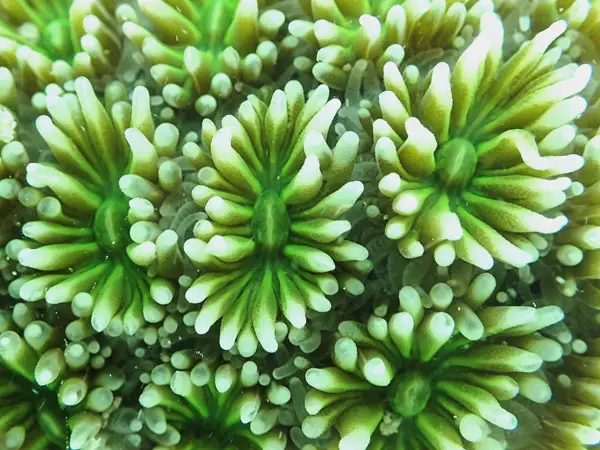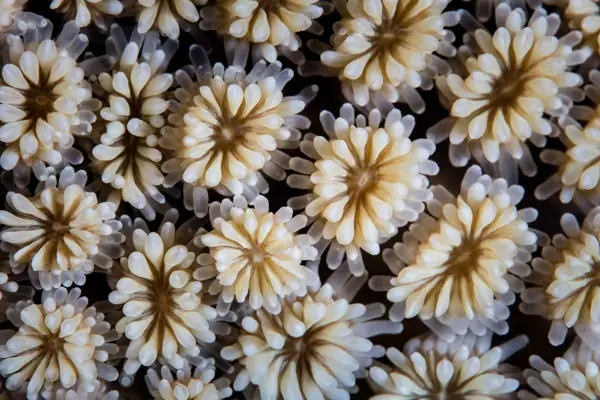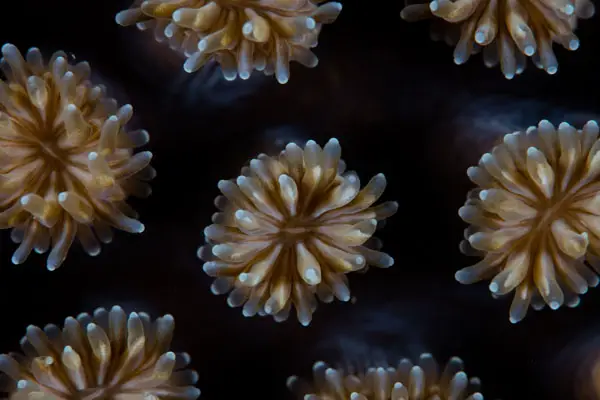The galaxea coral (Galaxea fascicularis) attracts hobbyists with its stunning arrangement of tentacles. Regardless of your color choice, you’ll end up with a beautiful display of waving white tips. And in no time, your saltwater aquarium will have a thriving colony. But galaxea corals aren’t the easiest species to manage. Those gorgeous tentacles? They pack a wicked punch. (Never judge a book by its cover – or a coral by its beauty!)
Table of Contents: Galaxea Coral Care
The sweeper tentacles lying in wait are ONE aspect of galaxea corals new aquarists need to keep in mind. (Of course, it’s one of the more significant concerns in a reef tank) Since the species grows quickly, you need to pay attention to a few quirks in their management. Luckily, you’ll find all of the warnings and precautions in the links below. (Including everything you need to know about those vicious sweeper tentacles!)
- Quick Facts
- Description of the Galaxea Coral
- Creating the Ideal Galaxea World
- Galaxea Coral Feeding
- Galaxea Coral Behavior and Tank Mates
- Galaxea Coral Reproduction and Fragging
- Pros and Cons
- For More Information

Quick Facts
- Common Names: Galaxea coral, Tooth coral, Star coral, Crystal coral, Starburst coral, Brittle coral, Galaxy coral, Scalpel coral, Durian coral
- Scientific Names: Galaxea fascicularis
- Size: Individual polyps reach up to 6mm in diameter
- Minimum Tank Size: 50 Gallons (189L)
- Aggression Level: Aggressive
- Compatibility: Provide a wide berth around ANY coral species to prevent attacks
- Care or Experience Level: Moderate
- Feeding Recommended? Minimal – Will improve growth
- Lighting: Low-Moderate
- Water Flow: Moderate
- Original Part of the World: Indo-Pacific
Description of the Galaxea Coral
Galaxea corals belong to the large polyp stony (LPS) coral group. They form columns of calcium carbonate connected with thin plates. (If you break out a magnifying glass, you’ll see ridges along the surfaces) The colony structures can form domes, balls, spires, or even branches depending on the environmental conditions. All of them have one thing in common, though: they’re DELICATE.
The plates don’t provide a ton of reinforcement between the tubes. It’s a lightweight design. Great for growth, but not so hot for handling. As such, it’s easy to break galaxea coral skeletons. (Hence that common name of brittle coral) When you handle frags, you need to take extreme care. You don’t want to damage the structure accidentally. Every “wound” leaves the colony at risk for infections (brown jelly infection tops the list), recession, or even necrosis.
However, galaxea corals ARE considered hardy. And they grow at a rapid rate. This allows them to dominate reef fringes in the wild. (Well, and the fact they’re SUPER aggressive) The encrusting variety easily swarms over available rocks, pushing out any other species that might decide to move into an area. You don’t usually see encrusting galaxies in home aquariums, though. The dome and ball types are more popular.

Galaxea corals come in plenty of vibrant colors. Green shows up in fish stores the most, though. If you hunt around, you’ll find browns, grays, pinks, purples, and tans. At the tip of the tentacles – regardless of the color – the polyp is white. And that’s where “galaxea” comes from. Galaxios is Greek for “milky” (no, not “galaxy” – I know, it’s a shocker). So the genus Galaxea refers to the ends of the tentacles.
And you get to enjoy those white tips plenty. Galaxea corals extend their tentacles throughout the day. Not to the full extent, though. Simply enough to wave in the current and create a dynamic reef tank. It’s one of the reasons they’re so popular with aquarists. But DON’T let those seemingly-short tentacles fool you. They’re simply biding their time until nightfall. Then they extend into the current and turn into wicked weapons of destruction. (Only slightly exaggerating, as we’ll get to in a minute)
Creating the Ideal Galaxea World
As with other impressive species, galaxea corals show up on reefs throughout the Indo-Pacific. You’ll find them in the Red Sea and around South Africa, across to Tonga, the Solomon Islands, and around the Great Barrier Reef, and then up to the China Sea and Japan. They’re not found terribly deep or in the shallows. (Think Goldilocks) Divers spot them in the range of 10-82 feet (3-25m).
Galaxea corals stay on the shore side of fringing reefs. This protects them from the waves and harsher currents. But they’re not fans of sandy substrates. As such, you’ll want to offer live rock or other hard aquascaping for the skeletons to attach to. And once the galaxy corals find somewhere comfortable? They take over. No, seriously. Colonies can spread up to 6 feet (2m) in width! (Ultimate coral domination)
When snorkeling or diving, it’s common to swim over patches of a reef with galaxea corals and NO OTHER species present. They use their long sweeper tentacles (up to 12 inches/30.5cm) to clear out any potential invaders. It makes for an impressive display in the wild. And it’s something you’ll need to keep in mind when you set up your reef tank.
Galaxea Coral Tank Size
As fast-growing species, galaxea corals require a bit more space than some of the more “easy” LPS species out there. (Not to mention you have their aggression to consider) Most hobbyists choose dome varieties that won’t spread as much as encrusting types. However, you still want to provide enough space to allow for healthy growth. As such, you shouldn’t go any smaller than 50 gallons (189L).
And if you’re planning to keep multiple coral species? Err on the side of a larger tank. You’ll need to offer as much space around your galaxeas as possible. If you don’t, you’ll end up with dead corals. (Placement only goes so far if space is a premium)

Galaxea Coral Water Parameters
Galaxea corals do well with standard water parameters. You want to ensure you’re following the proper needs for an LPS species to survive and grow:
- Temperature: 76-81F (24.4-27.2C)
- Salinity:023-1.025
- Alkalinity: 8-11dKH
- pH:2-8.4
- Calcium: 400-450ppm
- Magnesium: 1200-1350ppm
The addition of strontium and trace elements won’t hurt, either. Plenty of hobbyists dose their reef tanks to improve the health and well-being of their corals. If you decide to go this route, you’re looking for a strontium level of around 8-10ppm.
Officially, though, focus on your calcium and magnesium. And, yes, you need both. Magnesium makes calcium available to corals. So if you’re lacking in one, you’ll end up hurting the other. And since EVERY coral needs calcium to build up its skeleton, you don’t want to see a deficiency.
You also need to check your phosphate level. Galaxea corals HATE phosphates. You need to keep that level as close to 0ppm as humanly possible. If you’re managing your calcium and magnesium properly, though, this shouldn’t be a problem. (Phosphate and calcium trade with one another)
Galaxea Coral Placement
Galaxea corals thrive in the “Goldilocks” zone out on reefs. They don’t build colonies near the surface where sunlight’s the strongest. And you won’t find them terribly deep where light disappears. You WILL see them sheltered from wave action and harsh currents. And those are the parameters you need to keep in mind when considering the placement of your new additions.
In general, galaxeas don’t need a ton of light. They’ll do okay if you have lower light intensity in your tank. (A shocker for most coral enthusiasts who turn up the lights) If you reach for your best and brightest, you’ll end up frying the polyps. These corals will look stunning, even in dimmer conditions.
Your best bet is to aim for a moderate intensity – and then place your galaxea coral in the middle of the tank. That way, you won’t risk the lighting being too much. If you have other corals in the aquarium that need a brighter PAR, shift your galaxeas down. They’re not a species you need at the top of the tank.
As to the type of lighting, galaxea corals seem to tolerate almost anything:
- LEDs
- Metal halides
- Power compacts
- T-5s
If you’re monitoring the placement of the coral within the tank, you can get away with any light. It’s the position that’s key more than the PAR. You want that “butter zone” in the middle.
The same with your flow. Galaxea corals thrive OUT of the high current. And you don’t want them struggling in an increased flow environment. Set your powerheads on medium to provide the feeding opportunities the coral needs. If you go too strong, you’ll tear the polyps. (Remember, galaxea corals extend their tentacles during the day. So if you DON’T see them, your current’s too high) You should see a gentle swaying motion.
The biggest element to galaxea coral placement, though, is the space you clear around your frags. The species looks sweet and innocent. Little tentacles dance in the current – during the day. Then night falls, and the galaxea bares its fangs. Those tentacles stretch up to TWENTY TIMES in length! Suddenly, the sweeper tentacle can reach between 6-12 inches (15.2-30.5cm) from the coral.
And the stinging cells on the end? They’re NASTY! Galaxea corals come out at the top on the aggression scale. You won’t find many species that can survive a challenge. And that means providing a proper ring barrier around your white-tipped bully. If you don’t, you may wake up in the morning to find coral carnage. (While the galaxy coral sits innocently in the middle)

Galaxea Coral Feeding
With that aggressive streak, you might expect to need regular feedings for your galaxea. However, the species isn’t demanding – in that respect. Galaxea corals rely on their zooxanthellae symbiotes for the bulk of their diet. This means as long as they receive proper lighting conditions, the algae within their tentacles will keep them fed.
That doesn’t mean supplemental feedings won’t benefit their growth, though. If you choose, you can target feed your galaxeas a couple of times a week. You’ll need to grind the offerings into a paste, though. Galaxea polyps are TINY. And if you don’t get the food small enough, all you’ll end up doing is fouling your water.
Galaxea corals enjoy everything from protein to the usual coral foods:
- Brine shrimp
- DT’s Phytoplankton
- Marine Snow
- Mysis shrimp
- Phytoplex
Galaxea Coral Behavior and Tank Mates
Galaxea corals “dance” in mild currents. Protected from the harsh wave action by outer ridges of the reef, they enjoy the “snow” of plankton brought up from the depths. And they serve as homes for crabs, mussels, sponges, and shrimp. (A bonus you might discover when you purchase them from fish stores!) They don’t mind sharing space with these invertebrates – in the wild or the home aquarium.
It’s only corals and sea anemones that earn their wrath. The currents that bring them their meal also help them wage war on locals. The water flow carries the sweeper tentacles out to the neighbors. As the tentacle moves, it thins. They’re translucent, and even as a tiny “thread,” they pack a wallop. As soon as the sweeper tentacle makes contact, it releases those stinging cells. The result? Tissue damage. And galaxea corals usually win in a battle with other coral species.
But they’re not usually successful when it comes to battles with fish. Angelfish and butterflyfish LOVE coral polyps. And they’re not bothered by the sweeper tentacles. So you don’t want to combine galaxea corals with these known hazards to reef tanks.
You have PLENTY of other options when it comes to creating a stunning saltwater aquarium, though (and these species know how to mind their manners):
- Anthias
- Basslets
- Batfish
- Blennies
- Boxfish
- Cardinalfish
- Clownfish
- Damselfish
- Dartfish
- Dragonets
- Gobies
- Groupers
- Jawfish
- Hawkfish
- Lionfish
- Puffers
- Seahorses
- Squirrelfish
- Wrasses
Galaxea Coral Reproduction and Fragging
Galaxea corals in the wild reproduce sexually. Female colonies form tiny red eggs. Then males produce sperm. You also have a third colony that makes egg-like structures that float. Sperm attach to the faux eggs so they can drift to the eggs. Fertilization occurs, and the eggs hatch into free-swimming planula larvae.
Once a planula finds somewhere on the reef to settle, it metamorphosizes into a miniature polyp. The polyp will start to excrete a calcium carbonate skeleton. Boom! A new colony forms and grows. Of course, most planulae end up eaten by other creatures on the reef. So you’ll also find fragmentation as a popular asexual method of reproduction method for galaxea corals.
You CAN frag galaxeas. You need to take care with the process, though. Those brittle skeletons may end up with damage you weren’t intending. You’ll want to use a wire saw blade and choose even segments. You then need to choose a new home for your frag AWAY from other corals. Or you can suspend the segment while it heals.
Galaxea corals will heal and multiply. Captive propagation makes the species easy to find and purchase. Always check that any frags you’re interested in look healthy, though. That delicate skeleton can easily lead to damage and infection. And you don’t want to introduce a diseased polyp into your tank.

Pros and Cons
Galaxea corals put people in mind of – well, galaxies. And when you see the colonies spread throughout a tank, you can’t help but want one of your own. But you want to exercise some caution before you rush to the local fish store. As beautiful as they are, galaxeas present a few challenges.
Pros
- Galaxea corals grow quickly, making it easy to propagate new colonies.
- You don’t need to worry about obtaining particular lighting types to keep galaxeas, as long as you place them under low to medium intensity.
- Galaxea corals obtain most of their nourishment from their zooxanthellae.
Cons
- Galaxea corals have sweeper tentacles that reach up to 20 times their daytime length, requiring careful placement in your reef tank.
- The skeleton of a galaxea is brittle, leading to damage and infections such as brown jelly if you’re not careful with your handling.
- Galaxea corals are aggressive, usually coming out on top of any coral interactions.
For More Information
As far as LPS corals go, galaxea corals require a touch more experience than some species. They’re hard to resist, though. Those bursts of color swaying in a current create gorgeous displays. And trying to catch a glimpse of the cellophane-like sweeper tentacles? (You know you want to) It’s intriguing to consider. So if you want to ensure you have as much information as possible on this bully coral, read on!
This YouTube video goes through everything you need to know about galaxea corals:
Want to know about some of the best galaxea coral tank mates?
Maybe galaxea corals (and their aggressive streak) are a bit much for you right now. Let’s consider some gentler species:
Conclusions
When you’re on the breakable side, you need a hefty defense. And that’s why galaxea corals are so nasty. (Okay, maybe that isn’t why they’re such brutes) You need to keep their aggressive nature in mind before you add one to your reef tank, though. Not to mention monitoring those light levels.
But if you’re up to the challenge, you couldn’t ask for a better-looking coral. Galaxeas sway in the current, mesmerizing with those white tips. And who knows? Maybe you’ll snag a new little crab hitchhiker in the process!
References
- Borneman, E. 2004. Aquarium Corals: Selection, Husbandry, and Natural History.
- Calfo, A. 2007. Book of Coral Propagation.
- Erhardt, H. and Moosleitner, H. 2005. Marine Atlas Volume 2: Invertebrates.
- Lemon, T.Y.K. 2016. “Galaxea fascicularis: Wolf in Sheep’s Clothing.” Reefs.
- Shimek, R.L. 2005. Guide to Marine Invertebrates: 500+ Essential-to-Know Aquarium Species.

Leave a Reply